This article examines the costs associated with solar energy to give you a clear understanding of its economic footprint.
Key takeaways:
- Solar panel installation costs depend on various factors.
- Government incentives and rebates can offset the initial investment.
- Solar panels offer advantages like reduced electricity bills and increased property value.
- Solar power systems can provide a return on investment over time.
- Tips for saving money on solar panels include accurate system sizing and exploring financing options.
Solar Panel Installation Cost Breakdown

The initial cost of solar panel installation varies depending on several factors such as the size of the system, the type and quality of solar panels, and the complexity of the installation. Residential systems typically range between $3,000 and $10,000 per kilowatt of energy capacity.
Labor costs contribute significantly to the overall price and can fluctuate based on the installer’s experience and the location of the home. The type of roofing on a home can also impact labor costs, as some materials are easier to work with than others.
Equipment costs encompass the panels themselves, inverters, mounting hardware, and additional electrical components necessary for functionality. Higher-efficiency panels, while more expensive upfront, can yield greater savings over time due to increased energy production.
Permitting and inspection fees are usually required by local governments and can add to the installation price. These costs are typically fixed and are a necessary part of ensuring the system meets local building codes and safety standards.
Overall, these costs are front-loaded, with minimal expenses after initial setup aside from maintenance and potential repairs. It’s crucial to obtain quotes from multiple providers to compare costs and services, ensuring a more informed decision-making process.
Government Incentives and Rebates
Understanding the range of government incentives and rebates is key to evaluating the affordability of solar energy. Many countries offer tax credits, which reduce the amount of federal taxes owed by a percentage of the system’s cost. For example, in the United States, the Solar Investment Tax Credit (ITC) allows homeowners to deduct a significant portion of their solar installation costs from their federal taxes.
Additionally, some local governments provide cash rebates to offset the initial investment even further. These rebates often decrease over time as solar adoption grows and costs naturally decrease, encouraging early adoption.
Net metering policies play a critical role as well. Surplus energy generated by home solar panels can be sold back to the grid, effectively earning homeowners credits on their utility bills.
Performance-based incentives (PBIs), such as Solar Renewable Energy Certificates (SRECs), offer another method to recoup costs. In states with an SREC market, homeowners can earn certificates for the energy they produce and sell them to utility companies.
To navigate these financial options effectively, homeowners should research specific local and national programs since incentives and rebates vary greatly by location and over time.
Pros and Cons of Solar Panels for the Home
Solar power presents several advantages for homeowners. It significantly reduces electricity bills thanks to the ability to generate free power from the sun after the initial setup costs. Home solar installations also increase property values, offering a selling point for energy-conscious buyers.
Furthermore, solar panels contribute to reduced carbon emissions, aligning with eco-friendly practices.
On the flip side, the upfront cost for purchasing and installing a solar system can be a barrier for some homeowners. The performance of solar panels is weather-dependent; regions with less sunshine may yield lower energy production.
In addition, solar technology may require a significant amount of space on rooftops or land, and this might be a constraint for some properties. Lastly, while maintenance costs are generally low, potential damage to panels or the need for eventual replacement should be considered.
Potential Return On Investment
Understanding the financial returns of solar investment hinges on factors like energy savings, system lifespan, and increasing property values. Typically, a solar power system considerably reduces monthly electricity bills, with savings starting to accrue immediately after installation. These savings compound over time, often enabling the system to pay for itself within 7 to 20 years, depending on local energy costs and solar resource availability.
As utility rates rise, the comparative savings can grow, making the return on investment more attractive. In addition, homes with solar panels often see a boost in market value, offering a potential return should the property be sold.
Maintenance costs for solar power systems are usually low, ensuring that ongoing post-installation expenses do not significantly diminish returns. The panels’ performance warranty, which generally guarantees output for 25 years, ensures a long-term predictable benefit. Furthermore, net metering can contribute to returns by providing credit for the surplus energy that a system feeds back into the grid, thus increasing overall savings.
How To Save Money On Solar Panels
Opt for an accurate system size by conducting a comprehensive analysis of your energy needs to avoid overspending on superfluous capacity.
Seek multiple installation quotes to ensure competitive pricing and find the best deal suited to your requirements.
Investigate local installers for potentially lower prices compared to national companies and the benefit of community references.
Consider purchasing less costly, moderately efficient solar panels if your roof space is ample, balancing overall installation cost with energy production.
Time your purchase to catch market dips as panel prices can fluctuate based on supply and demand dynamics.
Explore financing options such as solar loans or leases to distribute the initial cost over time while immediately enjoying reduced energy bills.
Take advantage of solar incentive programs offered by the government, which can dramatically decrease net costs.
Lastly, ensure your system is properly maintained to maximize its lifespan and efficiency, thereby optimizing your long-term savings.




